Review
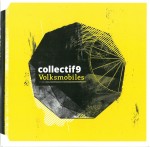 Volksmobiles is the quite fascinating first CD from collectif9 (collectif9.ca), the Montreal string ensemble that made its debut in 2011 and is composed of four violins, two violas, two cellos and a bass. The players met through their studies at McGill University and the Université de Montréal, and their assertion that the ensemble size enables them to combine the power of an orchestra with the crispness of a chamber ensemble is more than justified by the results here.
Volksmobiles is the quite fascinating first CD from collectif9 (collectif9.ca), the Montreal string ensemble that made its debut in 2011 and is composed of four violins, two violas, two cellos and a bass. The players met through their studies at McGill University and the Université de Montréal, and their assertion that the ensemble size enables them to combine the power of an orchestra with the crispness of a chamber ensemble is more than justified by the results here.Two arrangements by the group’s bass player Thibault Bertin-Maghit open the program: a simply dazzling version of Brahms’ Rondo alla zingarese (check out the video on their website!) and a short but effective transcription of the Allegretto from Alfred Schnittke’s Violin Sonata No.1.
The central work on the disc is the title track, a short three-part piece commissioned by the group from the Guelph composer Geof Holbrook. Its opening movement has more than a hint of Marjan Mozetich about it (no bad thing!) and the third movement is a clever mixture of percussive effects and pizzicato.
A condensed Allegro assai from Bartok’s Divertimento is a more substantial piece played with a great sense of style, and André Gagnon’s really short but exuberant Petit concerto pour Carignan, an homage to the legendary Quebecois fiddler Jean Carignan, rounds out the disc with a wicked cross-mixture of Bach and fiddle music.
I have only one complaint, and although it’s a big one it’s also a positive one: clocking in at just over 29 minutes for the seven tracks, the disc feels more like a sampler CD than a debut disc, and it certainly leaves you really wanting to see what the group does with a more substantial program. Hopefully we will be hearing a great deal more – in both quantity and length – from this dynamic ensemble in the not-too-distant future.
Concert Note: You can hear collectif9 live courtesy of Music Toronto at Jane Mallett Theatre on March 10. The program will include the Holbrook mentioned above and works by Brahms, Shostakovich, Bartók, Schnittke, Hindemith and Prokofiev.
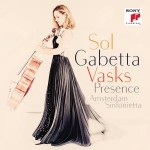 The Swiss-based Argentinian cellist Sol Gabetta is simply stunning in Vasks Presence, the world premiere recording of the Concerto No.2 for Cello and String Orchestra, “Klātbūtne – Presence,” which was written for her by the Latvian composer Pēteris Vasks (Sony 88725423122). The work, premiered in October 2012, was commissioned by the Amsterdam Sinfonietta, which is conducted here by Candida Thompson.
The Swiss-based Argentinian cellist Sol Gabetta is simply stunning in Vasks Presence, the world premiere recording of the Concerto No.2 for Cello and String Orchestra, “Klātbūtne – Presence,” which was written for her by the Latvian composer Pēteris Vasks (Sony 88725423122). The work, premiered in October 2012, was commissioned by the Amsterdam Sinfonietta, which is conducted here by Candida Thompson.
The concerto is described as portraying the hope that the individual may find peace and purification in a conflict-ridden here and now, and consequently has passages of both great beauty and dissonant struggle. There’s a glorious build-up throughout the opening Cadenza – Andante cantabile, a tough and choppy Allegro moderato with distinct shades of Shostakovich, and another lovely build through the Adagio final movement, Gabetta adding a really lovely and almost Bachian vocalise at the end, as the cello soars to the highest and quietest of endings.
Grāmata čellam – The Book is a two-movement work for solo cello, with a strong, percussive and impassioned Fortissimo followed by a Pianissimo that again requires Gabetta to add a vocalise. Written in 1978, it was the first work of Vasks that Gabetta heard and led directly to their ongoing friendship.
For Musique du soir for Cello and Organ, Gabetta is joined by her mother, the organist Irène Timacheff-Gabetta. Vasks has said that the evening of the title refers to the evening both of the day and of life; it’s a strongly tonal and very effective work.
The standard of Gabetta’s playing and interpretation throughout a challenging program is quite astonishing, especially in view of the amount of solo writing and the remarkably high and demanding technical level of the music. It is the Cello Concerto that really stands out here though, and as Vasks assisted with the recording this is clearly a definitive performance of what is a significant addition to the contemporary cello concerto repertoire. It’s a simply indispensable CD for anyone interested in the genre.
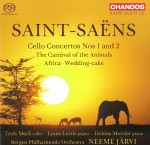 There’s another excellent cello CD this month, this time with cellist Truls Mørk as soloist in the Cello Concertos Nos.1 and 2 of Saint-Saëns on a Chandos Super Audio CD (CHSA 5162). Neeme Järvi conducts the Bergen Philharmonic Orchestra.
There’s another excellent cello CD this month, this time with cellist Truls Mørk as soloist in the Cello Concertos Nos.1 and 2 of Saint-Saëns on a Chandos Super Audio CD (CHSA 5162). Neeme Järvi conducts the Bergen Philharmonic Orchestra.
Saint-Saëns was an astonishingly gifted musician whose life spanned a period of enormous musical change – he was born eight years after Beethoven’s death and was still alive three years after the end of the First World War – but his music was often regarded as out-of-date almost as soon as it was written. Still, what music it is at times!
The two concertos, written in 1872 and 1902, must have been welcome additions to the solo cello orchestral repertoire, which was still quite thin on the ground by the late 1800s. Concerto No.1 in A Minor Op.33 is a three-movement work with a lovely Allegretto as the middle movement, while the Concerto No.2 in D Minor Op.119 is a shorter two-movement work with equally beautiful lyricism in the slower passages. Mørk plays with a warm tone and fine sense of style throughout both concertos.
The additional works on the CD offer ample proof of the composer’s all-round ability. Pianists Louis Lortie and Hélène Mercier join Alasdair Malloy on glass harmonica and members of the orchestra for a joyous performance of Le Carnaval des animaux, Grande Fantaisie zoologique for Two Pianos, Flute, Clarinet, Glass Harmonica, Xylophone and Strings. The work grew out of a cello solo – Le Cygne – which the composer wrote for a cellist friend in 1886, but while the famous Swan was soon published Saint-Saëns never allowed the entire work to be performed outside of a small circle of his friends; it remained unpublished until 1922, after the composer’s death. Not surprisingly, Mørk shines in his famous solo turn.
Two concert pieces for piano and orchestra complete a diverse and highly entertaining CD: the well-known Caprice-Valse Op.76 “Wedding Cake,” and the fantasia Africa Op.89, both of them showcasing the terrific talents of Louis Lortie.
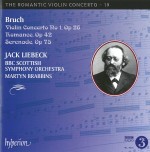 The outstanding Hyperion series The Romantic Violin Concerto reaches Volume 19 with three works by Max Bruch – the Violin Concerto No.1 in G Minor Op.26, the Romance in A Minor Op.42 and the Serenade in A Minor Op.75 – in performances by the English violinist Jack Liebeck and the BBC Scottish Symphony Orchestra under Martyn Brabbins (CDA68060).
The outstanding Hyperion series The Romantic Violin Concerto reaches Volume 19 with three works by Max Bruch – the Violin Concerto No.1 in G Minor Op.26, the Romance in A Minor Op.42 and the Serenade in A Minor Op.75 – in performances by the English violinist Jack Liebeck and the BBC Scottish Symphony Orchestra under Martyn Brabbins (CDA68060).
Bruch wrote three works officially designated as violin concertos, but that wasn’t the full extent of his compositions in that form; both the Scottish Fantasy and the Serenade included here are four-movement works that are concertos in all but name. The former was coupled with the Violin Concerto No.3 on Volume 17 of this series in performances by the same personnel.
Bruch was constantly exasperated by the popularity of the G minor concerto at the expense of his other – and in his opinion, better – violin concertos, but it remains probably the most popular of all the Romantic violin concertos. It’s given a lovely performance here.
Bruch’s other violin concertos are much better served by recordings now than they used to be, but even if you do know the other two concertos and the Scottish Fantasy the chances are that the Serenade will be new to you; if so, you’re in for a real treat. It’s a lengthy work from 1899, when the composer was 61 but still had more than 20 years left in his life. Written for and at the prompting of the Spanish virtuoso Pablo de Sarasate, it’s a simply beautiful work by a mature composer in complete control of his craft; the third movement Notturno in particular is absolutely gorgeous.
The single-movement Romance dates from 1874, some six years after the first concerto, and was intended as the opening movement of what Bruch thought would be a second concerto. The booklet notes describe it as “rather uneventful, although very beautiful,” the latter a word that regularly seems to crop up in discussions of Bruch’s music.
The noted English musicologist Sir Donald Tovey once said that “it is not easy to write as beautifully as Max Bruch.” That’s quite true – and it’s not easy to play as beautifully as Jack Liebeck, either. Add the outstanding orchestral support and the lovely recorded sound and you have a supremely satisfying CD.
Johannes Brahms was notoriously self-critical, often ruthlessly destroying early compositions as well as his ongoing revisions of existing works. As a result, musicologists rarely have the opportunity to observe the compositional process and to make comparisons between initial and final versions of Brahms’ works.
One welcome exception to this is the Piano Trio No.1 in B Major Op.8, presented in its original 1854 version along with the Piano Quartet No.3 in C Minor Op.60 on a new harmonia mundi CD by the Trio Wanderer (HMC 902222).
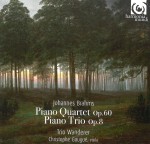 The trio was completed in early 1854, when Brahms was still only 20. By the time it was accepted by the Leipzig publisher Breitkopf and Härtel, Brahms was already having serious doubts about the work and considered withdrawing it, as he “would certainly have made changes in it later.” Although he did not prevent its publication he had nothing to do with the work’s premiere. When he did finally revisit the work 35 years later his revisions were so all-encompassing that they amounted to a virtual recomposition of the piece, and the admittedly more focused and structured result is the version usually performed today. The original version, though, is a delightful and by no means lightweight snapshot of the young Brahms, and makes us wonder again what we may have lost in the large number of destroyed early string quartets.
The trio was completed in early 1854, when Brahms was still only 20. By the time it was accepted by the Leipzig publisher Breitkopf and Härtel, Brahms was already having serious doubts about the work and considered withdrawing it, as he “would certainly have made changes in it later.” Although he did not prevent its publication he had nothing to do with the work’s premiere. When he did finally revisit the work 35 years later his revisions were so all-encompassing that they amounted to a virtual recomposition of the piece, and the admittedly more focused and structured result is the version usually performed today. The original version, though, is a delightful and by no means lightweight snapshot of the young Brahms, and makes us wonder again what we may have lost in the large number of destroyed early string quartets.
Trio Wanderer is joined by Christophe Gaugué on viola for the piano quartet, a work whose seeds were sown in 1855 in an unfinished quartet in C-sharp minor, two of the three movements being extensively reworked for the completed Op.60 in 1875.
The period of the work’s gestation, covering his relationship with Clara Schumann, together with Brahms’ comments to the publisher Simrock in which he likened himself to Goethe’s Romantic poet Werther (who committed suicide over an unrequited love) have led to suggestions that the quartet embodies Brahms’ unfulfilled love for Clara; certainly the passion and yearning – not exactly uncommon traits in Brahms’ music, it must be said – would seem to make it much more than a mere possibility.
Trio Wanderer performers – violinist Jean-Marc Phillips-Varjabédian, cellist Raphaël Pidoux and pianist Vincent Coq – all graduated from the Conservatoire National Supérieur de Musique in Paris in the 1980s and went on to study at the Juilliard School in New York. The trio was formed in 1987, and the lineup has been unchanged since Phillips-Varjabédian replaced the initial violinist in 1996. Their sensitive and beautifully recorded performances here make this new release a welcome addition to their impressive discography of some two dozen discs.



